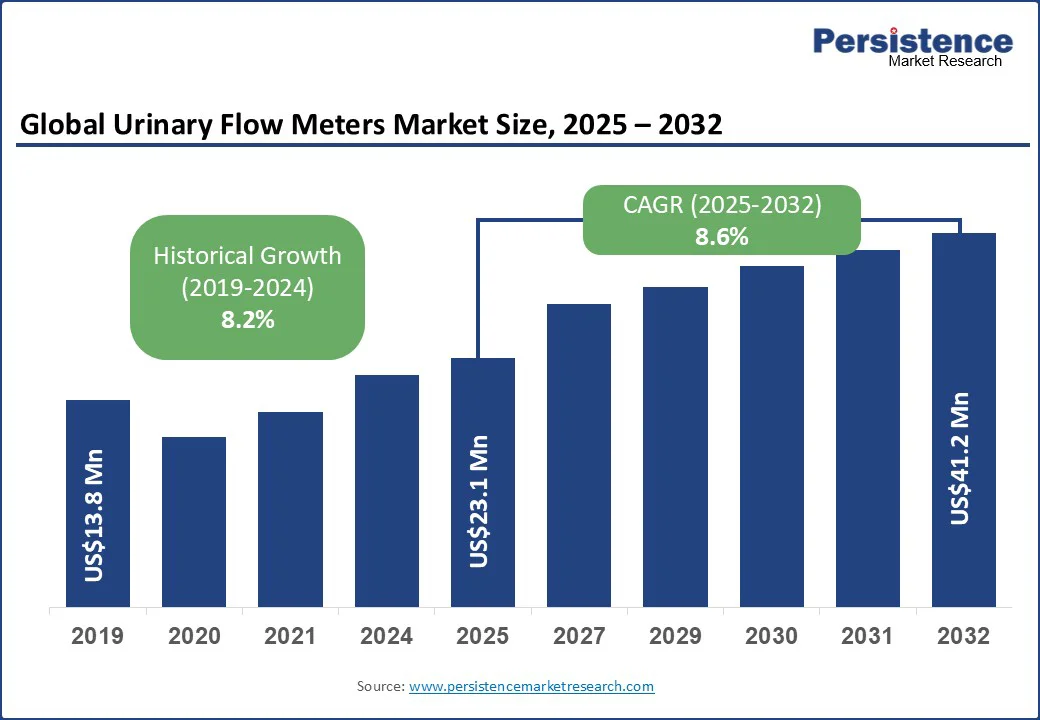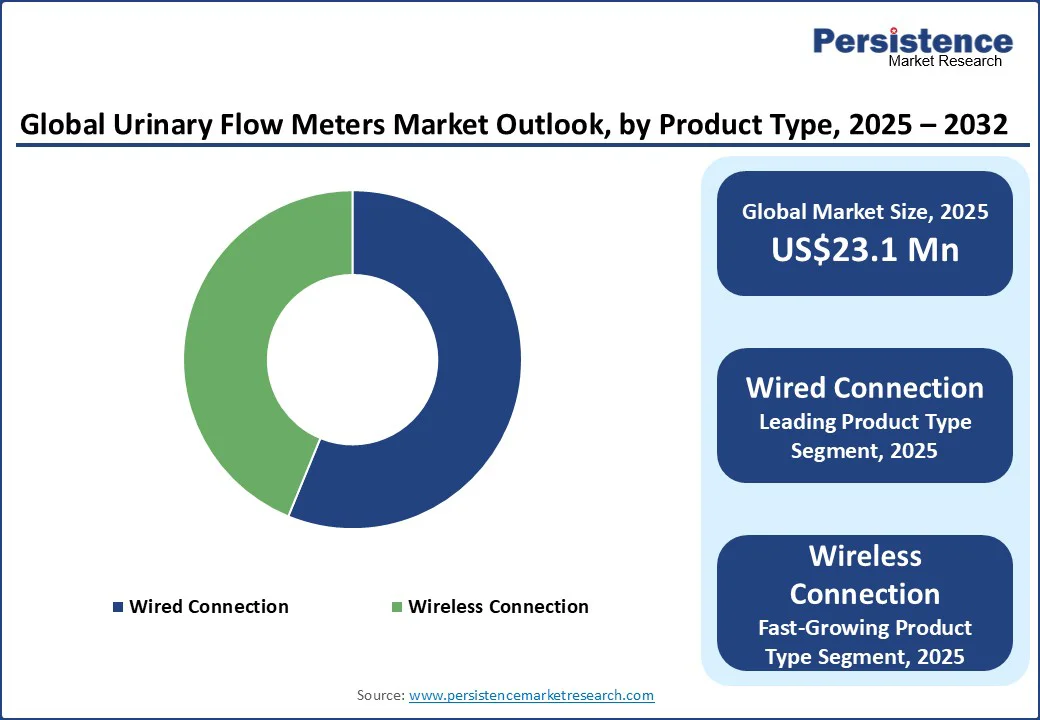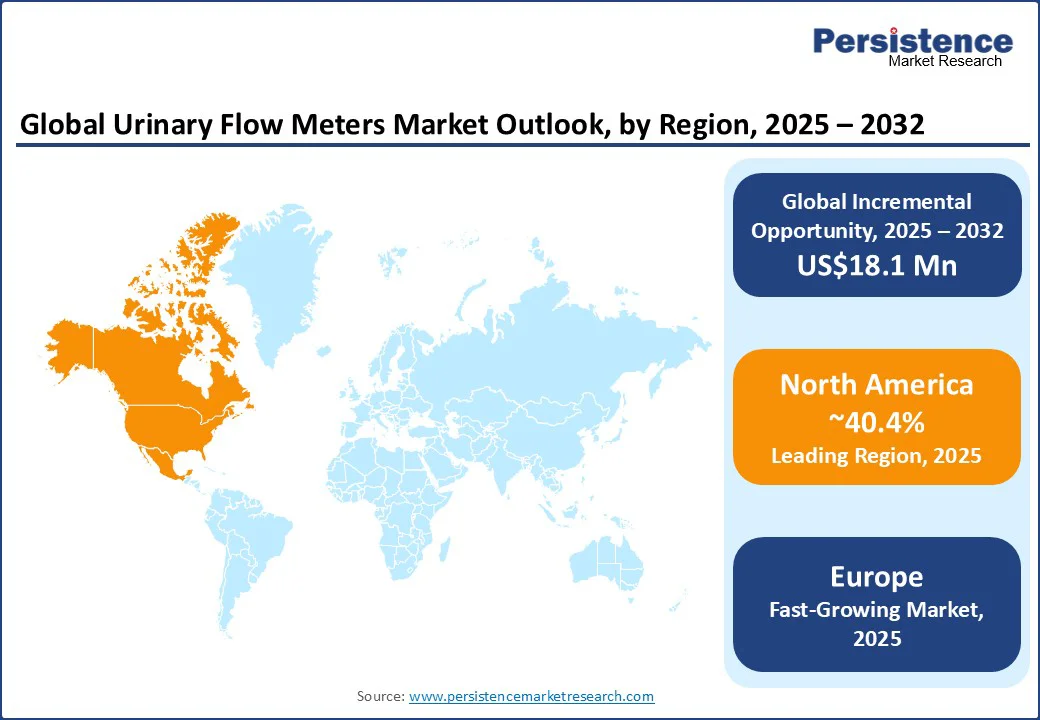ID: PMRREP35566| 196 Pages | 18 Aug 2025 | Format: PDF, Excel, PPT* | Industrial Automation

The global urinary flow meters market size is projected to rise from US$ 23.1 Mn in 2025 to US$ 41.2 Mn by 2032. It is anticipated to witness a CAGR of 8.6% during the forecast period from 2025 to 2032.
The urinary flow meters market growth is spurred by rising urological disease prevalence and the push for precision in patient monitoring. Key players are differentiating through targeted product development, connectivity integration, and strategic expansion into high-growth geographies. Recent strategies include the launch of wireless models for home and teleurology use, as well as acquisitions aimed at consolidating distribution networks.

Key Industry Highlights:
|
Global Market Attribute |
Key Insights |
|
Urinary Flow Meters Market Size (2025E) |
US$ 23.1 Mn |
|
Market Value Forecast (2032F) |
US$ 41.2 Mn |
|
Projected Growth (CAGR 2025 to 2032) |
8.6% |
|
Historical Market Growth (CAGR 2019 to 2024) |
8.2% |
The increasing prevalence of urinary tract disorders is boosting urinary flow meter demand by extending the patient pool requiring non-invasive urodynamic assessments. Conditions such as Benign Prostatic Hyperplasia (BPH), urinary incontinence, and neurogenic bladder are becoming increasingly common with global aging trends. According to an online survey, Europe’s male population over 60 has BPH prevalence rates exceeding 50%, while Asia Pacific is seeing incontinence rates in women surpass 25% in some urban areas. These disorders often require uroflowmetry as a first-line diagnostic test to evaluate bladder outlet obstruction or voiding dysfunction.
The burden of recurrent Urinary Tract Infections (UTIs) is also contributing to demand, mainly in elderly and diabetic populations. The Centers for Disease Control and Prevention (CDC) estimates that UTIs account for over 8 million doctor visits annually in the U.S. In pediatric care, conditions such as vesicoureteral reflux and dysfunctional voiding are prompting early screening with portable and child-friendly flow meters. In markets with a high incidence of chronic kidney disease (CKD) secondary to long-standing urinary obstruction, early detection through uroflowmetry is increasingly prioritized in outpatient settings.
Straining and incomplete bladder emptying introduce variability into urinary flow meter readings, often resulting in underestimation or overestimation of true voiding performance. When patients strain, they can artificially increase peak flow rates (Qmax) without corresponding detrusor muscle efficiency. It tends to mask bladder outlet obstruction in uroflowmetry results. A 2023 study in Neurourology and Urodynamics reported that manual straining increased recorded Qmax by up to 25% in male patients with lower urinary tract symptoms, potentially leading to false negatives in obstruction diagnosis.
Incomplete bladder emptying has the opposite effect, as it reduces the voided volume below the recommended diagnostic threshold. It is generally set at ≥150 mL for reliable readings in adults. In practice, residual volumes above 100 mL can depress Qmax and average flow rate values, giving the impression of detrusor underactivity even when obstruction is the primary cause. This is why several Europe- and North America-based clinics now integrate post-void residual ultrasound into uroflowmetry sessions, ensuring volume-adjusted interpretation.
The surge in home healthcare adoption is creating a commercial push for portable and connected urinary flow meters, as healthcare systems look to reduce hospital dependency. Home-based urology diagnostics witnessed steady growth between 2020 and 2024 in the U.S. and Europe, spurred by telehealth reimbursement policies and the emphasis on the remote monitoring of chronic urinary conditions. In this setting, urinary flow meters are transitioning from bulky clinic-only devices to lightweight and app-integrated units that patients can use in their homes.
The shift is evident among patients with intermittent symptoms, including episodic urinary retention and variable flow patterns, which often do not appear during a single hospital-based uroflowmetry test. Home-based devices enable multi-day monitoring, producing rich datasets and highly accurate diagnoses. Cost and convenience factors are also augmenting adoption. In Australia and Canada, where rural patients often travel hours to reach urology clinics, home urinary flow meters help reduce travel costs and waiting times, while keeping specialists informed in real time.
Based on product type, the market is bifurcated into wired and wireless connections. Among these, the wired connection segment is predicted to account for nearly 56.2% of the urinary flow meters market share in 2025 due to its ability to provide stable and interference-free data transfer, which is important for ensuring diagnostic accuracy. Wired models help maintain a continuous connection between the measurement unit and the analysis console. Clinicians also prefer these as they are less dependent on battery life, a common limitation in portable wireless units. In high-volume urology centers, wired meters help eliminate downtime from charging or battery replacement.
Wireless urinary flow meters are seeing steady demand as they enable high patient mobility and simplify workflow integration. This trend is evident in outpatient, home healthcare, and teleurology settings. By removing the tether to a stationary console, patients can empty their bladders in a more natural and private environment, which often produces more representative flow curves. Demand is further being spurred by the shift toward remote monitoring and connected care ecosystems. Modern wireless models integrate directly with smartphones or tablets, transmitting results to cloud-based platforms for real-time clinician review.
In terms of application, the market is divided into BPH, prostatitis, enuresis, spontaneous urinary incontinence, stress incontinence, bladder neuromuscular dysfunction, post-traumatic urethral stricture, and others. Out of these, BPH is anticipated to hold around 33.2% share in 2025 as it is one of the most common causes of Lower Urinary Tract Symptoms (LUTS) in aging men. Uroflowmetry is considered a frontline diagnostic tool for assessing its severity. Growth is also driven by its surging treatment volumes worldwide.
Prostatitis is a key application because inflammation of the prostate often causes major changes in urinary flow dynamics, which urinary flow meters can quantify in a non-invasive manner. Chronic prostatitis/chronic pelvic pain syndrome (CP/CPPS) affects an estimated 8% to 16% of men globally, according to a 2024 European Association of Urology review. This makes it one of the most common urologic diagnoses in men under 50. Novel readings hence help distinguish prostatitis-related obstruction from other lower urinary tract disorders such as BPH.

In 2025, North America is projected to account for approximately 40.4% of share due to the rising prevalence of benign prostatic hyperplasia, urinary incontinence, and neurogenic bladder disorders. These conditions are typically common in older male populations and are becoming more visible in younger groups due to sedentary lifestyles. This epidemiological backdrop creates consistent diagnostic demand, primarily for devices that can capture accurate and real-time urinary flow data. Hospitals remain the most prominent end-users, but adoption in outpatient and urology clinic settings is increasing.
PC-based urinary flow meters are gaining impetus in the U.S. urinary flow meters market owing to their high accuracy, automated measurement capabilities, and smooth EMR integration. These features help in drastically improving diagnostic efficiency. At the same time, local healthcare providers are embracing portable and wireless uroflowmetry devices with Bluetooth or cloud connectivity. These allow for real-time data transmission, remote consultations, and patient-friendly testing experiences. These features cater to the expanding telehealth infrastructure of the U.S.
Europe holds a substantial share of the urine flow meter market, backed by its booming healthcare infrastructure and widespread diagnostic adoption. Much of this growth is spurred by high rates of urological disorders and the dense presence of established medical device players. Leading domestic firms include MEDKONSULT Medical Technology, tic Medizintechnik, and Medica S.p.A. Their long-standing presence supports both product development and regional penetration.
A combination of regulatory support and aging populations further accelerates growth. Europe’s favorable reimbursement environment and proactive efforts by key vendors are boosting hospital and outpatient use. Technology trends point to the rising demand for wireless and IoT-connected meters across healthcare settings.
In Asia Pacific, China remains in the dominant position, followed by Japan, India, and South Korea. Demand is fueled by the rising prevalence of urinary disorders and surging awareness of urological diagnostics. According to a study published in BJU International, in China, higher rates of urolithiasis are observed in the eastern developed regions compared to the west, with Guangdong and Guangxi provinces leading in terms of prevalence.
Public health investments, specifically in China and India, have improved access to diagnostic tools. These have further increased the number of uroflowmetry procedures in both hospital and outpatient clinic settings. The increasing adoption of new technologies is another key growth driver. Wireless, wearable, and smartphone-linked uroflow meters are gaining popularity across Asia Pacific. These devices enable real-time monitoring, data storage, and integration with telehealth platforms, thereby appealing to both clinicians and patients seeking convenience.

The global urinary flow meters market is moderately consolidated at the high end, with a few established players dominating hospital-grade and fully integrated systems. Numerous regional manufacturers operate in the standalone and portable device segment, with competition largely defined by distinct product segmentation.
Premium hospital networks typically integrate novel software, EMG, and bladder pressure monitoring capabilities, catering to tertiary care centers that value complete urodynamic analysis. Small clinics and outpatient facilities, however, opt for compact and low-maintenance units that focus on ease of use and quick turnaround. Recent developments include wireless and Bluetooth-enabled devices for quick setup.
The urinary flow meters market is projected to reach US$ 23.1 Mn in 2025.
The increasing prevalence of lower urinary tract disorders and rising patient preference for non-invasive diagnostics are the key market drivers.
The urinary flow meters market is poised to witness a CAGR of 8.6% from 2025 to 2032.
Regulatory approvals for wireless home-use flow meters and expansion into emerging countries are the key market opportunities.
Apex Meditech, Dantec Medical, and CellSonic Medical are a few key market players.
|
Report Attribute |
Details |
|
Historical Data/Actuals |
2019 - 2024 |
|
Forecast Period |
2025 - 2032 |
|
Market Analysis |
Value: US$ Mn |
|
Geographical Coverage |
|
|
Segmental Coverage |
|
|
Competitive Analysis |
|
|
Report Highlights |
|
|
Customization and Pricing |
Available upon request |
By Product Type
By Device Type
By Application
By Region
Delivery Timelines
For more information on this report and its delivery timelines please get in touch with our sales team.
About Author